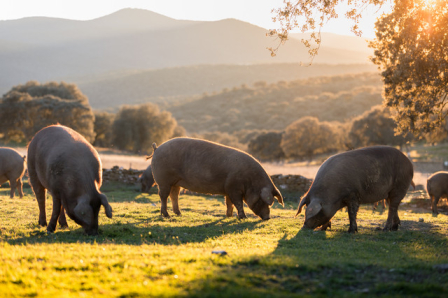Deciding where to go during your time in Andalusia can be difficult. There are so many places to visit! From the most amazing sights in the big cities, to cute white villages. And don´t forget about the nature and cultural experiences. To make the choice a bit easier for you we have listed our 10 favorite things you must see in Andalusia.
Alhambra
Rising above the modern city of Granada, is one of Andalusia´s most impressive monuments: Alhambra. It was built in 1238 by order of Muhammad I Ibn al-Ahmar but took more than a hundred years to be completed. Alhambra means ´red castle´ The Alhambra functioned as a fortress, a palace and a small medina (city) at the same time. Originally built only for military purposes, it has high walls and a strategic location overlooking the city and surrounding areas. All of its spectacular views, palaces, gardens and art pieces make Alhambra a must-see while in Andalusia. There´s also an independent palace in front of Alhambra that kings used as a peaceful resort. It is called Generalife and can be combined with Alhambra perfectly.
Visit an olive grove
Olive oil is an essential product to the Andalusian diet. It is used on bread, salads, gazpacho and many other typical dishes. In 2022, Andalusia was responsible for almost 80% of Spain´s olive oil production. That´s 34% of all olive oil production worldwide! Most of the ´liquid gold´ is coming from the province of Jaén, which is known as the world capital of olive oil.
There are many places where it´s possible to get an inside look at how the oil is made and walk through the olive groves. Of course you will also get to taste a variety of freshly made olive oil. The flavors might surprise you, as the aromas of pure olive oil can be very different than what you usually taste.

Cathedral of Seville
Seville as a whole can´t be missed while in Andalusia. But if you only have time for one thing, go admire the famous Cathedral of Seville. The cathedral stands on the site which used to belong to the Great Mosque of Seville. After the city was taken from the Moors in 1248 the mosque was replaced with a cathedral. Only La Giralda remains, which was transformed from a minaret into a bell tower.
The cathedral is known as the largest gothic cathedral in the world and houses many paintings and other art pieces, as well as the tomb of Christopher Columbus. It is definitely worth to go inside for a tour. It´s also possible to book a tour where you can enter the roof of the cathedral. To escape the heat this is done around sunset, conveniently providing spectacular views of Seville.

Doñana
In the west of Andalusia, divided by the provinces of Huelva, Seville and Cádiz, lies the Doñana National Park. This UNESCO World Heritage Site is famous for its diversity in landscape and ecosystems. In just one day you will get to see lagoons, marshland, pine groves, untouched white beaches and more. The wetlands provide a necessary home to many different bird species, including five endangered ones. During migrating season even more species can be found at the park. Besides birds, the park is also home to wild boars, badgers, deer and the endangered Iberian lynx. You can make your way through the park in various ways like with a 4×4 vehicle or a boat.
Ronda
Ronda is a historic city in the province of Málaga. Its most popular attraction is the bridge known as Puente Nuevo, which offers amazing views of the city and surrounding area. The bridge crosses the El Tajo Gorge that divides the city into two. On one side you have the 15th century ´new´ town and on the other side you have the old town with Moorish influences. Both have narrow, cobbled streets to explore.
Some other sights that are worth a visit while in Ronda are the Arab baths and Plaza de Toros, one of Spain´s oldest bullrings. Even if you are not into the sport, it is still an interesting cultural visit.

Visit to an Iberian pig farm
Ham production is a rich tradition in Andalusia that dates back centuries. The region has an ideal climate and terrain to raise and cure some of the world´s finest hams, particularly the renowned Jamón Ibérico. The Iberico pig grazes freely in the Andalusian oak forests known as ´dehesas´. Here they feed on a natural diet of acorns, herbs and other wild vegetation. This diet gives a unique nutty flavor to the ham. A visit to a pig farm can be a great way to spend the day. You will learn more about the raising and curing process and get to taste some of the best ham you will ever eat.

Córdoba
Córdoba – a city where history and culture mix in a unique way. Once the capital of Islamic Spain, Córdoba was a place where Muslims, Jews and Christians lived together in peace. This blend of cultures has given many interesting sites to the city. Its historic old town is a World Heritage site, full of little streets to be explored. Explore the iconic Mosque-Catedral, stroll through the charming Jewish Quarter, and get panoramic views from the Calahorra Tower.
There are many lively taverns where you can watch a flamenco show or indulge in local cuisine like Salmorejo, a refreshing cold tomato soup often topped with bits of boiled egg and cured ham. Or try a Flamenquin, another of Córdoba´s specialties, a deep-fried pork dish.

Marbella
Looking to relax? Marbella is the perfect spot for you. Looking for anything else? Marbella is likely still the perfect spot for you. This city combines comfortable, wide beaches with a vibrant nightlife, cute historic town, museums and world-class golf courses.
Marbella is also synonymous with luxury, attracting a high-profile clientele from around the world. The marina of Puerto Banús is a prime example of this, featuring more luxury yachts, high-end boutiques, and gourmet restaurants than you can count.

Cádiz
Cádiz is a city that lives and breathes history and tradition. Its history is older than Spain itself. The city was founded around 1100 years B.C, which makes it the oldest continuously inhabited city in western Europe. In the meantime it has been home to many cultures and civilizations – Phoenicians, Greek, Visigoth, Roman, Moorish and of course the Spanish. The city is surrounded by the sea so there´s always a nice breeze even on the really hot days.
Cádiz is best explored on foot. Wander through the historic town before making your way to the extensive beach. Go to the market and try some pescaíto frito, fried seafood often wrapped in a newspaper to eat out of. Relax in one of the beautiful parks. A day in Cádiz is the best way to reset a busy mind.

La Manquita
The cathedral of Málaga, officially known as the Santa Iglesia Catedral Basílica de la Encarnación, is a magnificent and historic cathedral located in the heart of the city of Málaga. Commonly referred to as La Manquita, which translates to “The One-Armed Lady,” this name stems from the fact that one of its towers remains unfinished to this day.
Construction of the cathedral began in the 16th century on the site of a former mosque after the Catholic Monarchs, Ferdinand and Isabella, conquered the city in 1487. The original plan was to build two towers, but due to financial constraints and other factors, only one was completed. This resulted in an asymmetrical appearance that has become one of the cathedral’s distinctive features that locals and tourists love about the cathedral.











